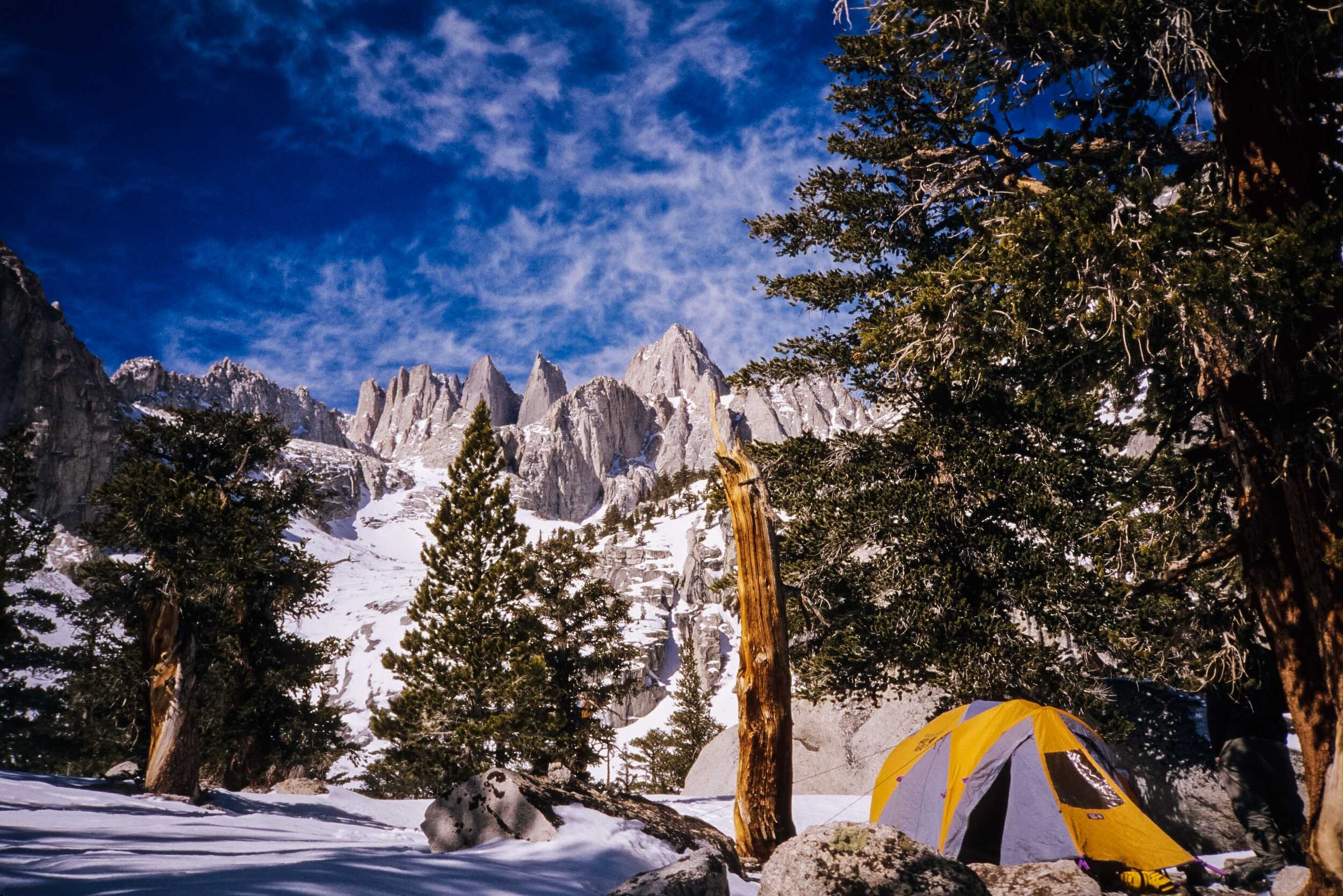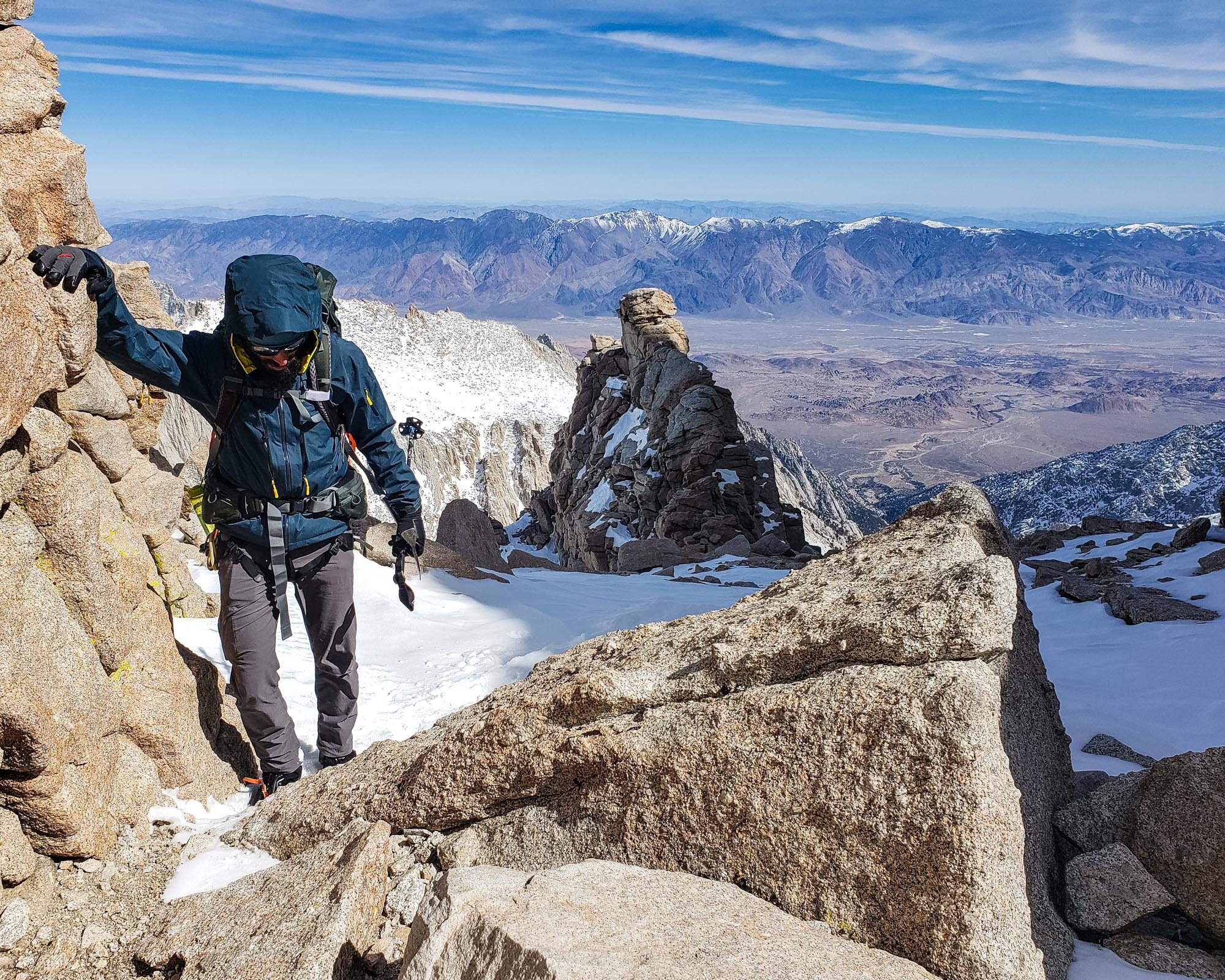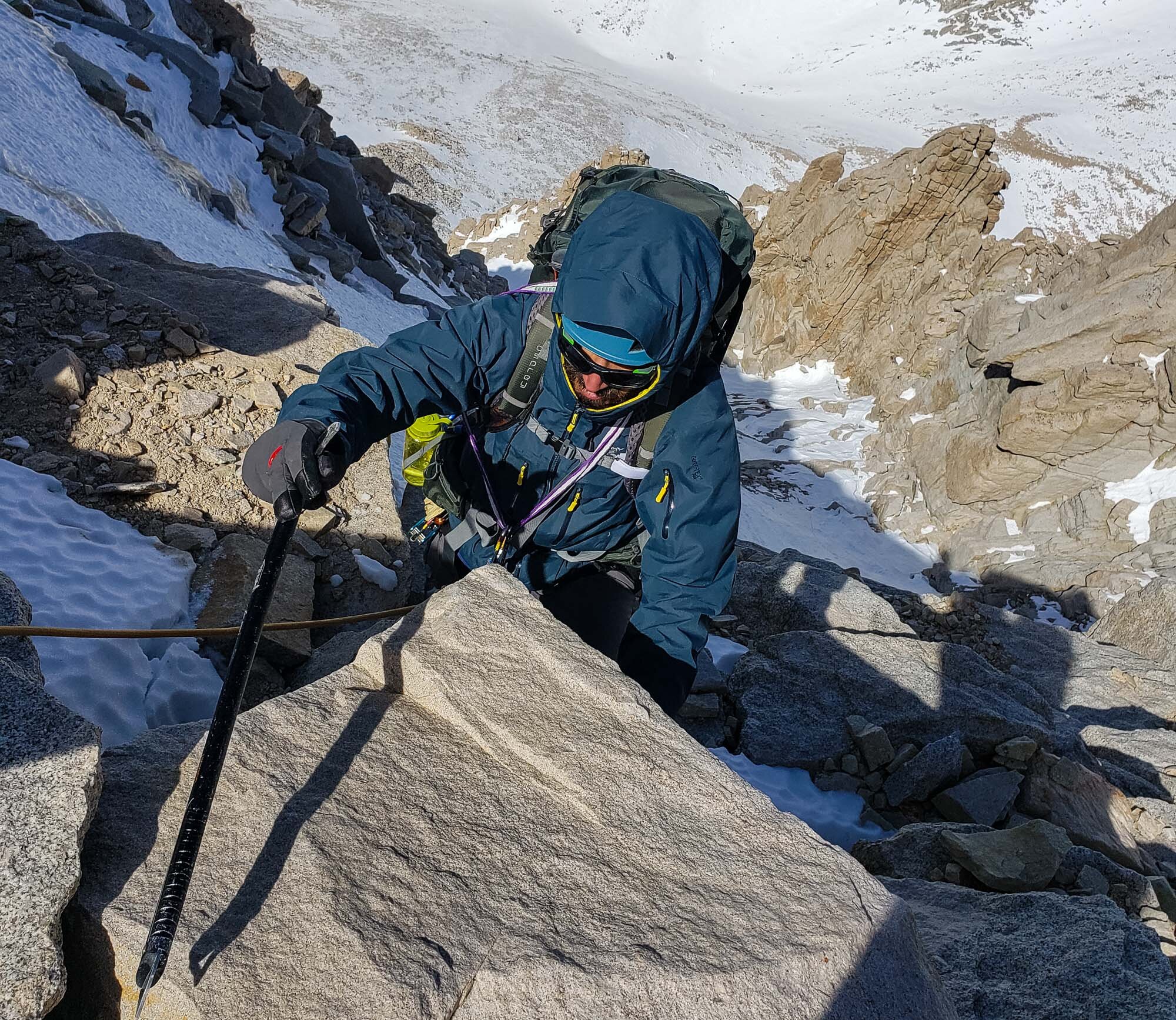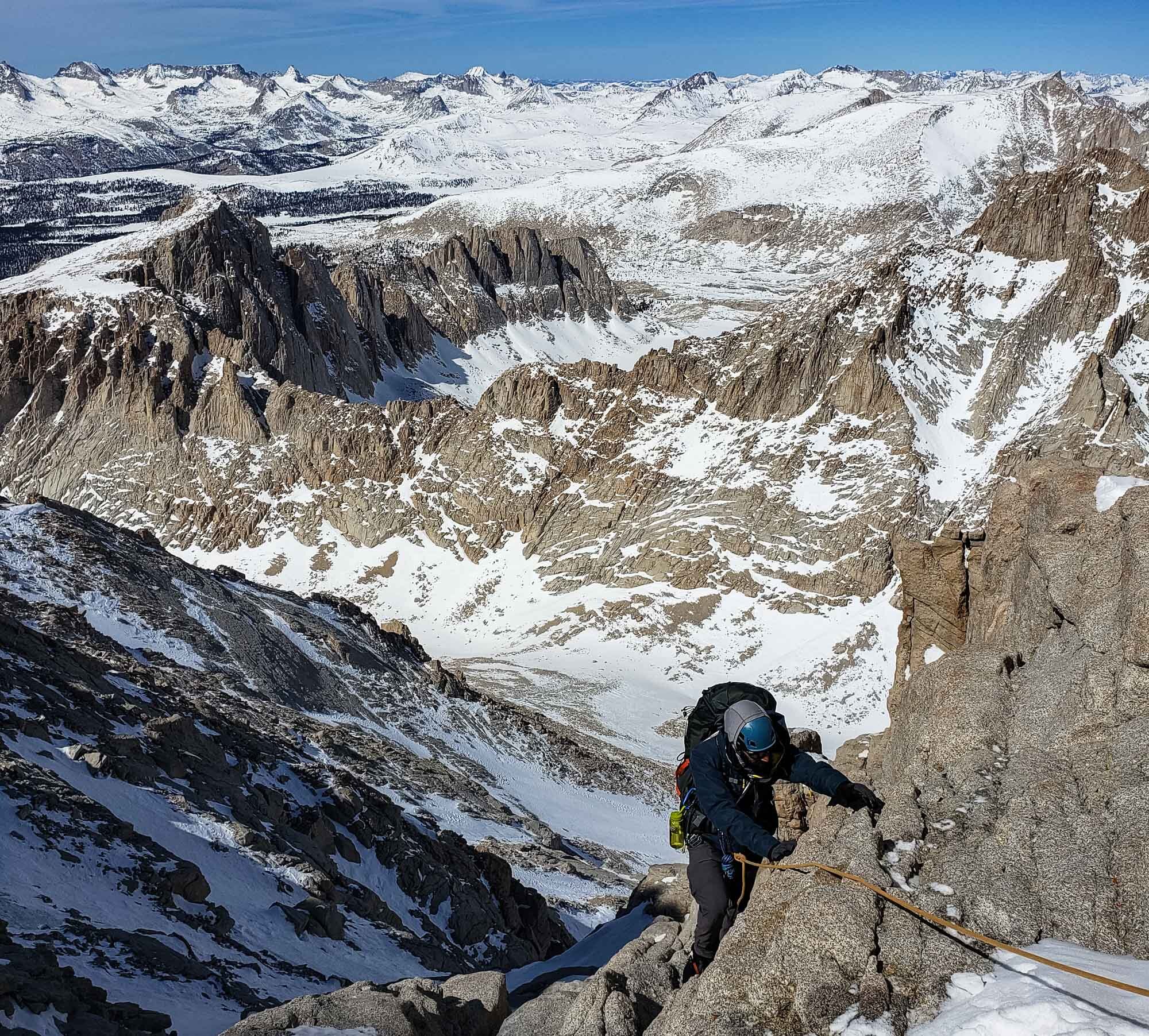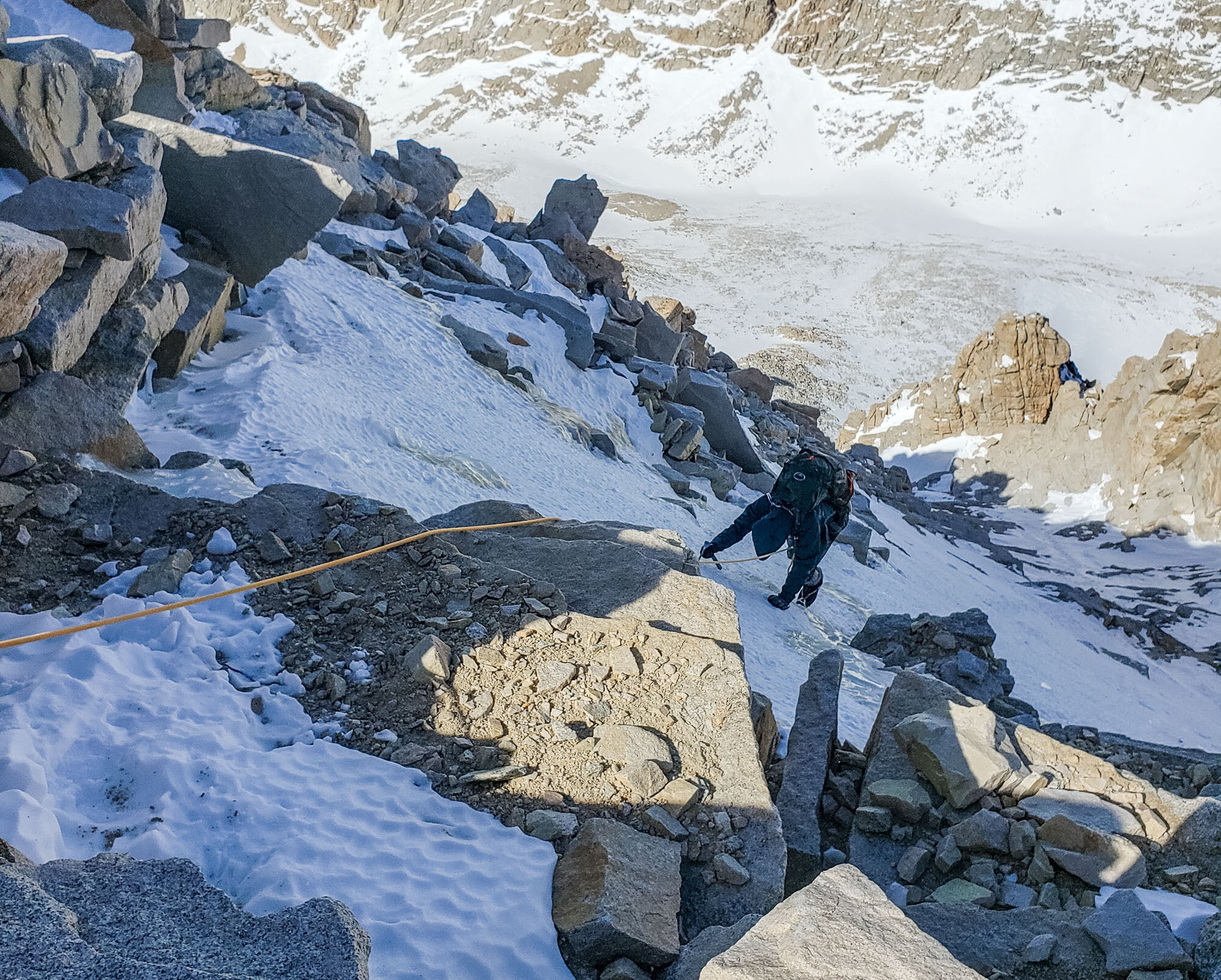MT. WHITNEY WINTER CLIMB
The Mountaineers Route, Mt Whitney (14,505 ft)
Sierra Nevada- 4 days
California Alpine Guides
a division of International Alpine Guides.
Mt. Whitney Winter Climb Overview
Climb Mount Whitney, the highest peak in the lower 48 states, in the winter via the mountaineer’s rote. A great climbing challenge for anyone wishing to get more into mountaineering, our guided Mt. Whitney winter ascent is a goal of many aspiring mountain climbers.
We take 4 days to ascend Mt. Whitney from below the Whitney Portal area; snowshoes are needed for much of the approach to high camp. On summit day, we don crampons and break out the ice axes to climb the mountaineer’s route in winter. Along the way’ our AMGA trained or certified mountain guides will teach you many of the skills necessary for winter mountaineering. The winter mountaineering instruction we teach on the winter Mt. Whitney climb is for those who want mountaineering training at a higher level. The winter Mt. Whitney ascent is a perfect training climb for those with Denali goals or other mountain climbing goals in ranges outside of California.
A completely different climb in the winter than in the busy summer season, climbing Mt. Whitney in the winter requires a different set of skills. Excellent physical condition is required as well as lots of stamina. The objective hazards of a winter snowpack are of course a big difference as well. We carefully assess the snow and avalanche conditions to ensure a safe winter ascent.
We begin the climb below the Whitney Portal (where exactly depends on the road closure) and make our way slowly up towards our goal for the first night, Lower Boy Scout Lake. The next day we bump camp even higher, usually a location between Upper Boy Scout Lake and Iceberg Lake. Day three is summit day in which we ascend the 35-degree mountaineers route couloir in full winter snow conditions. Near the top of the climb, things get a bit steeper and we normally use anchored belayed climbing in the last 200 feet to the summit of Whitney. We retrace our steps back to high camp and then snowshoe and hike out the last day. Altogether, a fantastic experience!
With Alpine Skills International… for 40 years we have been guiding Mt. Whitney with hundreds of successful ascents in both winter & summer. As California’s oldest and most experienced mountain guide service, you know you’re in good hands with us. All our technical Mt. Whitney lead mountain guides have training by the AMGA in the terrain they are working.
Join us this winter and spring on Mt Whitney!
EXPERIENCE & PHYSICAL FITNESS REQUIREMENTS
Previous snow climbing or mountaineering experience using an ice axe and crampons is required.
Previous backpacking experience is required.
Previous off-trail hiking experience on uneven terrain is required.
Excellent physical condition required.
Climbing Mt Whitney in the winter is strenuous… you must train accordingly! Please feel free to contact us for any training recommendations.
Curious how to rate your physical ability? Check out our Physical Ability Page
Recommended prior courses and trips:
WINTER 2026 DATES
February 20-23
March 6-9
March 27-30
April 10-13
April 24-27
COST:
$1735
We include all technical gear & camping gear at no extra cost!
INCLUDES
Breakfast & dinner while in the backcountry.
Group camping equipment, such as tents and cooking equipment.
All technical climbing equipment is provided at no extra cost.
Sleeping bag and pad, backpack, snowshoes, if needed. ($25 cleaning fee for using our sleeping bags).
Professional AMGA trained and/or certified professional mountain guides.
Winter boot rentals available at $10 per day
We can arrange custom dates for individuals and groups from late Dec through late-March
For more info on this trip please fill out the form below:
THE INTERNATIONAL ALPINE GUIDES DIFFERENCE
For over 40 years IAG/ASI team have been guiding on Mount Whitney & throughout California, as well as on many of the great peaks of the world. As one of the most experienced and oldest guide services in California, we bring to you the highest standards in the mountain guiding industry. All of our mountain guides operating in technical terrain have training with the American Mountain Guides Association (AMGA) in the terrain they guide. We are also one of the most experienced American mountain guiding companies operating in the Alps of Europe and Latin America. Our extensive worldwide experience, adherence to the highest standards, as well as our approachable down to earth guiding philosophy all combine to give you, our valued guests, the best mountain experience possible.
All of our programs are developed and supervised by internationally licensed IFMGA guide Dave Miller, our founder and technical director. Dave has over 20 years of personal guiding experience on Mount Whitney. We know Whitney & the High Sierra!
MOUNT WHITNEY WINTER CLIMB ITINERARY
Day 1
We meet first thing in the morning in the town of Lone Pine for a meeting and quick pack check. We then drive up Whitney Portal Road and park up the road as far as we can go…sometimes well below Whitney Portal. We then hike up the road and past Whitney Portal to where, conditions dependent, we put on snowshoes for the ascent to camp. In a normal winter snowpack, we usually can avoid the Erbersbacher ledges. Our goal is to make camp for the night at Lower Boy Scout Lake.
Day 2
After breakfast, we continue our ascent to high camp. Passing by Upper Boy Scout Lake, we make our way up between there and Iceberg Lake to set in our high camp with spectacular views of Keeler Needle. Today, we will have time to review the mountaineering techniques needed for our ascent such as ice axe and crampon use.
Day 3
Summit day. An early dawn start rewards us with early morning alpenglow on the needles as we climb towards Iceberg Lake. Above, we ascend the mountaineers route snow couloir, possibly with an ice axe and crampons and the use of a rope for security. At the notch, things get a bit steeper, up to 45-degree snow and possibly some ice. We use belayed and anchored travel techniques on this last section before the summit. Once on top, we are rewarded with views in all directions…and no crowds! We make our way back to camp for the night.
Day 4
After sleeping in a bit, we break camp after breakfast and descend back towards our cars usually arriving between noon and 2 pm.
Itinerary subject to change



